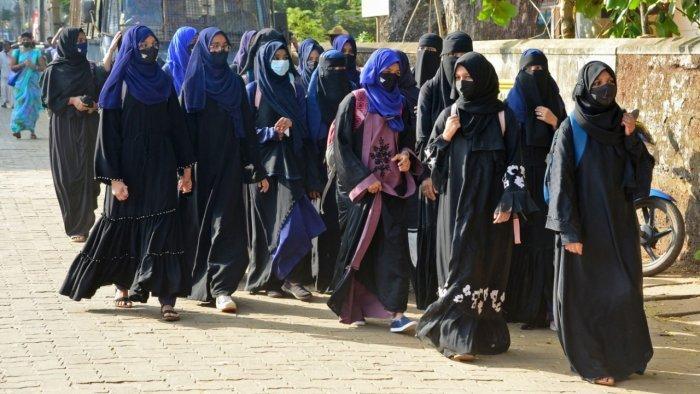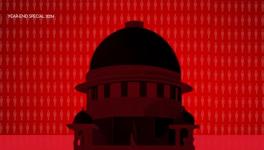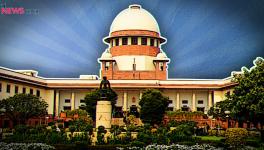Hijab Ban: Concept of ‘Qualified Public Space’ is Contrary to Article 19, Supreme Court Told

Representational Image. Image Courtesy: PTI
Petitioners’ counsel cite the unique nature of discrimination faced by Muslim women, international conventions which India has ratified, several Supreme Court judgments including the landmark decision in Puttaswamy, to buttress their contentions against the high court judgment.
——
The Supreme Court bench comprising Justices Hemant Gupta and Sudhanshu Dhulia continued to hear on Thursday a batch of petitions challenging the ban on wearing hijab in educational institutions in Karnataka based on the Karnataka Government Order on Dress Code for Students (‘GO’) and Karnataka Education Act, 1983, which was upheld by the Karnataka High Court on March 15.
Intersectional discrimination
Advocate Jayna Kothari based her arguments on intersectional discrimination faced by Muslim girls under Articles 14 and 15(1) where the prohibition on the grounds of sex and religion intertwines. In this case, she told the court that the GO perpetuates multiple levels of discrimination against Muslim girls. She referred to the Kenya High Court’s judgment in JWM (alias P) versus Board of Management O High School & 2 others and Patan Jamal Wali versus the State of Andhra Pradesh(2021), to substantiate her arguments.
Kothari told the bench that this court in two instances, in Patan Jamal and in Navtej Singh Johar& Ors versus UOI(2018) (‘Navtej’), has recognised that persons with intersecting identities may face multiple grounds of discrimination under Article 15(1) due to the intersecting of identities. Thus, the interpretation of grounds of discrimination under Article 15(1) as ‘any of the grounds’ would lead to a narrow interpretation of anti-discrimimation. It would also reject the historical discrimination and unique lived experience of certain sections of society of the minority groups.
Kothari referred to a decision of the United Kingdom (Watkins Singh, Regina v. The Governing Body of Aberdare Girls’ High School), where a girl, whose father belonged to the Sikh religion and whose mother was from Scotland, was allowed to wear a Kara (steel bracelet) despite the fact that the school had a policy that disallowed any jewellery. The court allowed the girl to wear Kara based on the argument that her fellow students’ religious beliefs were not intervened by the uniform policy of the school and thus, they did not suffer a disadvantageous position like that of the girl.
She told the court that the above decision is relevant because the UK court recognised that it was not in the position to evaluate the threshold of religious practice. The fact that merely there is a disadvantage that someone is prevented from wearing something which they consider a part of their religion would be a threshold enough. The same threshold, she argued, would apply to invoke Article 15(1) irrespective of whether the hijab is proved as an essential religious practice or not.
Lastly, she referred to The Convention on the Elimination of All forms of Discrimination Against Women(‘CEDAW’), specifically Articles 1 & 2, which India has ratified, to argue that the public institutions are obliged to act in conformity with the state obligation under the Convention that also includes taking measures to eliminate all forms of discrimination against women.
Meenakshi Arora’s arguments
Further, senior advocate Meenakshi Arora told the court that the Karnataka Government was not competent to enact a GO or any legislation that would be in conflict with the central legislation, that is the Commission for the Protection of Child Rights Act, 2005 which is based on the UN Convention on the Rights of the Child(‘UNCRC’). She told the court that this aspect has not been considered by the Karnataka High Court.
The UNCRC is based on the principle that the best interests of the child are one of the primary obligations that the states must respect. Since UNCRC protects the right of the child to exercise his/her faith and prohibits discrimination based on religion, how could Karnataka enact such a law when India has ratified the Convention under Article 253, she asked.
Arora told the bench that the world is a melting pot of the global population; therefore, religious tolerance within schools, if taught to the children, can imbibe respect for others’ cultures and religion.
Article 30 of UNCRC takes into consideration that a child belonging to an ethnic, linguistic or religious minority must not be denied her right to enjoy her own culture or religion or language. We have adopted this Convention as a whole, and therefore, we are obliged to respect these rights, she submitted.
Arora referred to the UN Human Rights Committee that has observed that banning headscarves is against the UNCRC. It has been found that it is counterproductive by neglecting the principle of the best interest of the child and the right of the child to access education, she told the court. The dress code must encourage the participation of the children and not exclude them from the school setting, she suggested.
Arora told the court that the Constitutional Court of South Africa, in a judgment, recognised the right of a Hindu girl to wear a nose-stud as a part of religious practice on the grounds of reasonable accommodation.
The Constitutional Court of South Africa has held that the principle of reasonable accommodation is relevant in practices that appear neutral on the face of it and designed to serve a valuable purpose. However, it has a marginalising effect on certain portions of society. Second, the principle is particularly applied in specific localised contexts, such as an individual workplace or school, where a reasonable balance between conflicting interests may more easily be struck, Arora said, concluding her submissions.
Advocate Shoeb Alam, representing two school-going girls, told the court that even a prisoner has fundamental rights as held in Sunil Batra versus Delhi Administration (1979). Their rights are not taken away at the gate of the prisons. There may be a shrinkage of rights but the rights are not surrendered, as has been observed by this court in Puttaswamy, he stated.
Colin Gonsalves’s submission
Senior advocate Colin Gonsalves based his arguments on essential religious practice under Article 25.
He told the court that even Bijeo Emmanuel & Ors vs State of Kerala & Ors(1986) on religious practice was argued before the Karnataka High Court, but the court did not even entertain that line of arguments. The Karnataka High Court, he stated, observed that once the essentiality of the practice is not established, there is no point in considering the violation of other related rights.
The high court judgment is from a majority perspective, Gonsalves said. Arguing on constitutional morality which, he says, must be cultivated as held in Navtej, he asked the court to see the issue from the eyes of the minority.
What better way to learn about religion than from their fellow mates? he asked the court. He referred to Ms. Aruna Roy & Ors versus UOI & Ors (2002) which observed that the meaning of secularism in India must be understood in a positive way.
He told the court that the impugned judgment of the Karnataka High Court runs contrary to 23 judgments of the Supreme court that protect the tenets of the religion.
Right to expression as part of autonomy
Senior advocate, Kapil Sibal argued that dress is an expression of itself and is at the heart of privacy. “If this right is available in a public place, does this get extinguished when I enter the school?”, is the question this court must adjudicate, he submitted. The court will have to find the answer in Article 19. Can the limits of Article 19(2) be transgressed by a notification? Will that not violate my Article 19(1)? , he asked.
Referring to the term ‘qualified public space’ used by the Karnataka High Court, Sibal claimed that there is no concept of qualified public space under Article 19. They are trying to create a different jurisprudence under Article 19, he said.
“What’s the point of having a Constitution that protects composite culture if I am not permitted to wear something that expresses me? Please refer to Article 51A(f). In fact, the Karnataka Education Act recognises the need to value and preserve the rich heritage of composite culture. It’s a fundamental duty of the citizens to preserve their culture and it’s in consonance with Article 29”, he explained.
“The court must consider whether there is a fundamental right to express and cultural identity flows from Article 19(1)(a). The GO violates the autonomy of girls and women, their dignity and access to the right to education. The court must set aside this order for being manifestly arbitrary”, he concluded.
Right to dress
Proscribing of hijab does not fall within clauses (2) to (6) of Article 19, advocate Prashant Bhushan told the court by way of intervention. A private club can impose a dress code but a public educational institution cannot. When the bench asked if the schools cannot even have a uniform dress code, he answered that the schools cannot do that. Even if I assume that they have the power to decide on a uniform dress code, it is not covered in any of the six grounds under Article 19(2). Privacy in Puttaswamy’s judgment flows from Articles 19(1) and 21 which include the right to dress.
“The state has singled out the hijab, which is a mark of Muslim identity. There is no rationale behind it. If you say that there is a rationale, you must proscribe symbols of all religious identities”, Bhushan argued.
Lastly, he told the court that the hijab may not be prescribed by Islam, but over the years it has acquired identity that is directly related to tenets of their religion. “We do not need to consider if this is an essential religious practice. There must be a bona fide religious belief. Thus, this also violates Article 25”, he asserted.
The court will continue to hear the petitions on Monday at 2 p.m.
Gursimran Kaur Bakshi is a staff writer at The Leaflet
Get the latest reports & analysis with people's perspective on Protests, movements & deep analytical videos, discussions of the current affairs in your Telegram app. Subscribe to NewsClick's Telegram channel & get Real-Time updates on stories, as they get published on our website.
























